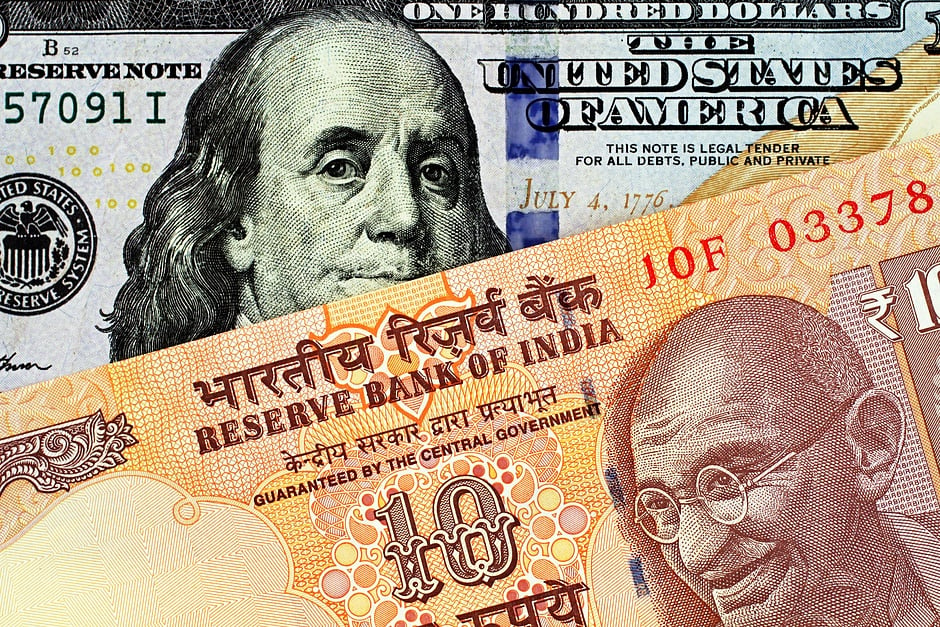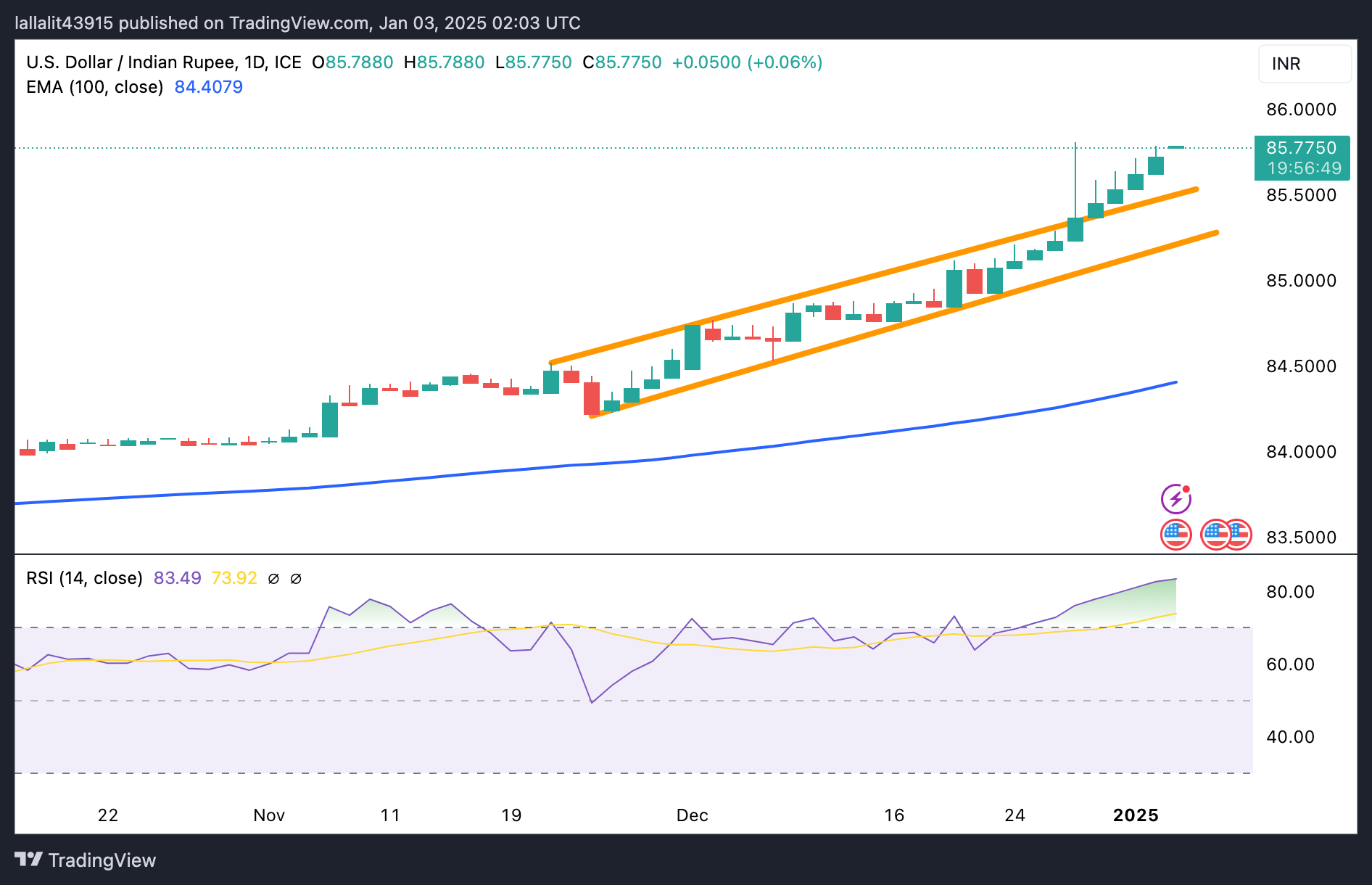Created
: 2025.01.03













![]() 2025.01.03 11:37
2025.01.03 11:37
The Indian Rupee (INR) extends the decline on Friday after closing at its weakest level on record for the eighth consecutive session. The local currency remains under pressure as the heavy US Dollar (USD) demand in the non-deliverable forward (NDF) market has widened the arbitrage with the Indian onshore market. Additionally, the discouraging growth rate in India, a wider trade deficit, and a slowdown in capital inflows contribute to the INR's downside.
Nonetheless, the Reserve Bank of India (RBI) might intervene to sell the USD and offer short-term relief for the INR. Traders await the US December ISM Manufacturing Purchasing Managers Index (PMI) for fresh impetus, which is due on Friday. Also, the Federal Reserve Bank of Richmond President Thomas Barkin is set to speak later in the day.
The Indian Rupee trades with a negative bias on the day. According to the daily chart, the strong uptrend of the USD/INR pair remains intact since the pair broke above the ascending trend channel over the past week. The path of least resistance is to the upside as the pair holds above the key 100-day Exponential Moving Average (EMA).
However, the 14-day Relative Strength Index (RSI), with a reading above 70, suggests an overbought condition and signals that further consolidation cannot be ruled out before positioning for any near-term USD/INR appreciation.
In the bullish event, the first upside barrier emerges at the all-time high of 85.81. Sustained trading above the mentioned level could pave the way to the 86.00 psychological mark.
On the downside, the initial support level for USD/INR is located at the resistance-turned-support level of 85.54. A breach of this level could see a drop to 85.00, the round figure. The next contention level to watch is the 100-day EMA at 84.40.

The Indian Rupee (INR) is one of the most sensitive currencies to external factors. The price of Crude Oil (the country is highly dependent on imported Oil), the value of the US Dollar - most trade is conducted in USD - and the level of foreign investment, are all influential. Direct intervention by the Reserve Bank of India (RBI) in FX markets to keep the exchange rate stable, as well as the level of interest rates set by the RBI, are further major influencing factors on the Rupee.
The Reserve Bank of India (RBI) actively intervenes in forex markets to maintain a stable exchange rate, to help facilitate trade. In addition, the RBI tries to maintain the inflation rate at its 4% target by adjusting interest rates. Higher interest rates usually strengthen the Rupee. This is due to the role of the 'carry trade' in which investors borrow in countries with lower interest rates so as to place their money in countries' offering relatively higher interest rates and profit from the difference.
Macroeconomic factors that influence the value of the Rupee include inflation, interest rates, the economic growth rate (GDP), the balance of trade, and inflows from foreign investment. A higher growth rate can lead to more overseas investment, pushing up demand for the Rupee. A less negative balance of trade will eventually lead to a stronger Rupee. Higher interest rates, especially real rates (interest rates less inflation) are also positive for the Rupee. A risk-on environment can lead to greater inflows of Foreign Direct and Indirect Investment (FDI and FII), which also benefit the Rupee.
Higher inflation, particularly, if it is comparatively higher than India's peers, is generally negative for the currency as it reflects devaluation through oversupply. Inflation also increases the cost of exports, leading to more Rupees being sold to purchase foreign imports, which is Rupee-negative. At the same time, higher inflation usually leads to the Reserve Bank of India (RBI) raising interest rates and this can be positive for the Rupee, due to increased demand from international investors. The opposite effect is true of lower inflation.
![]()
Created
: 2025.01.03
![]()
Last updated
: 2025.01.03

FXStreet is a forex information website, delivering market analysis and news articles 24/7.
It features a number of articles contributed by well-known analysts, in addition to the ones by its editorial team.
Founded in 2000 by Francesc Riverola, a Spanish economist, it has grown to become a world-renowned information website.
We hope you find this article useful. Any comments or suggestions will be greatly appreciated.
We are also looking for writers with extensive experience in forex and crypto to join us.
please contact us at [email protected].
Disclaimer:
All information and content provided on this website is provided for informational purposes only and is not intended to solicit any investment. Although all efforts are made in order to ensure that the information is correct, no guarantee is provided for the accuracy of any content on this website. Any decision made shall be the responsibility of the investor and Myforex does not take any responsibility whatsoever regarding the use of any information provided herein.
The content provided on this website belongs to Myforex and, where stated, the relevant licensors. All rights are reserved by Myforex and the relevant licensors, and no content of this website, whether in full or in part, shall be copied or displayed elsewhere without the explicit written permission of the relevant copyright holder. If you wish to use any part of the content provided on this website, please ensure that you contact Myforex.
Myforex uses cookies to improve the convenience and functionality of this website. This website may include cookies not only by us but also by third parties (advertisers, log analysts, etc.) for the purpose of tracking the activities of users. Cookie policy